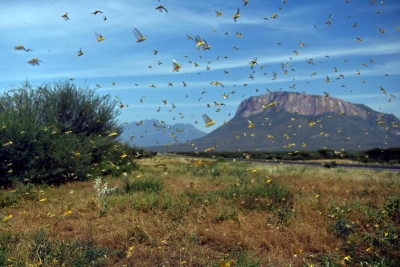
Locusts are large insects. They are special grasshoppers. They have big hind legs used for jumping. All grasshoppers (except the long-horned, ones) belong to the Acridoidea family, and the most important Locusts are all in the family Acrididae. Locusts can change their habits and, behaviour when they occur in large numbers their numbers rise they stay together in dense groups called, “swarms.” These are groups of adults. Locust groups are called “bands” when; they consist of the wingless young ones, commonly called ‘hoppers’. Locust swarms migrate over great distances, and, this behaviour differentiates them from other grasshoppers. When, locusts are in small numbers they live their individual lives like ordinary grasshoppers. These could be small groups that stay in one place. Some species of locusts are regarded as intermediate between grasshoppers that live alone and typical locusts that do not.
Locusts have the capacity to multiply rapidly and produce groups or swarms in special circumstances. Their population explosion can be started by unusual weather conditions or changes in land use. This is what happened this year. According to the UN, the heavy infestation this year can be traced back to cyclone season of 2018-19 that brought heavy rains to the Arabian Peninsula. This allowed at least three generations of “unprecedented breeding” and no one noticed it. Swarms have since spread out into South Asia and East Africa. David Phiri, a FAO regional, coordinator said that whew weather conditions are good for locust breeding, there is a high probability that the insects will continue to spawn rapidly. This year it may go on till April. Locusts have probably been man’s enemies ever since humans began to grow crops. The Old Testament (Bible) and the Koran mention the desert Locust. You can see carved, images of Locusts in Sixth Dynasty (2420-2270 BC) tombs at Saqqara in Egypt. Now, in countries like Somalia, Locusts can determine whether people will have sufficient food or starve. The damage they cause can be mild to very severe. This depends on whether the swarms are moving about quickly or whether they stay for several days in one area.
FAO describes the desert Locust, schistocerca gregaria, as the world’s “most dangerous migratory pest, with a, voracious appetite unmatched in the insect world.” Swarms can vary from, less than 1 sq km (0.38 square miles) to several, hundred. Each square kilometre can contain at Least 40 million insects, according to FAO. FAO’s Western Africa joint Locust control force was established, in 2016 and includes Mauritania, Algeria, Burkina Faso, Morocco, Niger, Senegal, Chad, Libya, and Mali.
Picture Credit : Google

